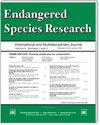Contemporary sightings of eastern North Pacific right whales, 2006 to 2023
IF 2.9
2区 环境科学与生态学
Q2 BIODIVERSITY CONSERVATION
引用次数: 0
Abstract
ABSTRACT: North Pacific right whales Eubalaena japonica once numbered in the 10s of 1000s. Today, the eastern population is one of the most endangered large whale stocks in the world. A lack of dedicated surveys and a population in the 10s of animals have resulted in considerable knowledge gaps. Here, we collate all contemporary sightings of eastern North Pacific right whales (ENPRWs) from 2006 through 2023 to investigate possible migratory routes and elucidate important habitat. Sightings in the northern Bering Sea, Gulf of Alaska, and along the west coast of North America have increased. Of the 99 sightings recorded between 2006 and 2023, 58 occurred during the few dedicated ENPRW surveys with simultaneous aerial and vessel platforms. All animals sighted were non-calves. Opportunistic sightings along the California coast were only reported in spring months (February-May). While this timing would coincide with a northward migration from lower latitudes, poor photo quality prevented matching of these animals, making it difficult to determine migratory patterns. Furthermore, there have been no sightings in Hawai’i or Mexico since 1996, and no sightings in the eastern North Pacific off the continental shelf since the 1970s. To date, only 2 animals have been photographically matched from Alaska to more southerly latitudes, and there have been no photographic matches between the Bering Sea and the Gulf of Alaska. Feeding has been observed throughout their range, suggesting right whales opportunistically feed whenever possible. While their primary migratory destinations remain unknown, these recent sightings provide insight into important ENPRW habitat in Alaska.2006 年至 2023 年当代北太平洋东部露脊鲸出没情况
ABSTRACT: 北太平洋露脊鲸 Eubalaena japonica 的数量曾经达到 10 万头。如今,东部种群已成为世界上最濒危的大型鲸鱼种群之一。由于缺乏专门的调查和数量只有 10 多头的种群,造成了相当大的知识差距。在此,我们整理了 2006 年至 2023 年期间所有当代北太平洋东部露脊鲸的目击事件,以调查可能的洄游路线并阐明重要的栖息地。在白令海北部、阿拉斯加湾和北美西海岸发现的露脊鲸数量有所增加。在 2006 年至 2023 年期间记录的 99 次目击事件中,有 58 次发生在为数不多的 ENPRW 专项调查期间,这些调查同时使用了空中和船上平台。所有发现的动物均为非犊牛。只有在春季(2 月至 5 月)才有报告称在加利福尼亚沿岸偶然发现了鲸鱼。虽然这一时间与从低纬度向北迁徙的时间相吻合,但由于照片质量较差,无法与这些动物进行比对,因此很难确定迁徙模式。此外,自 1996 年以来,在夏威夷和墨西哥没有发现过这种动物,自 20 世纪 70 年代以来,在北太平洋东部大陆架外也没有发现过这种动物。迄今为止,从阿拉斯加到更南纬度地区只有两只动物通过照片匹配,白令海和阿拉斯加湾之间也没有照片匹配。在露脊鲸的整个活动范围内都能观察到其觅食行为,这表明露脊鲸在可能的情况下都会择机觅食。虽然它们的主要洄游目的地仍然未知,但最近的这些发现让人们对阿拉斯加重要的 ENPRW 栖息地有了更深入的了解。
本文章由计算机程序翻译,如有差异,请以英文原文为准。
求助全文
约1分钟内获得全文
求助全文
来源期刊

Endangered Species Research
BIODIVERSITY CONSERVATION-
CiteScore
5.50
自引率
6.50%
发文量
38
审稿时长
31 weeks
期刊介绍:
ESR is international and interdisciplinary. It covers all endangered forms of life on Earth, the threats faced by species and their habitats and the necessary steps that must be undertaken to ensure their conservation. ESR publishes high quality contributions reporting research on all species (and habitats) of conservation concern, whether they be classified as Near Threatened or Threatened (Endangered or Vulnerable) by the International Union for the Conservation of Nature and Natural Resources (IUCN) or highlighted as part of national or regional conservation strategies. Submissions on all aspects of conservation science are welcome.
 求助内容:
求助内容: 应助结果提醒方式:
应助结果提醒方式:


